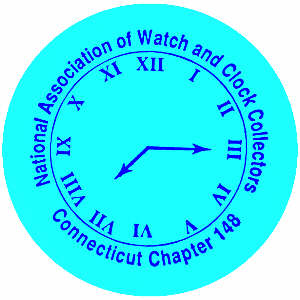
|
Jim Katzin, Pres.
jimkatzin@optonline.net
Cheryl A. Comen, Sec./Tres.
409A Montauk Lane
Stratford, CT 06614
(203) 378-4323
|
Meetings Past
Meeting Highlights - Nov. 20, 2004
by Mary Jane Dapkus
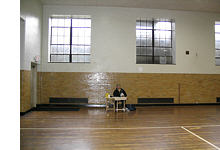 Chapter 148 met on Saturday, November 20, 2004. Perhaps the most revealing testament to our Chapter's vitality is the fact that more folks sought table space in the ample Edmond Town Hall gymnasium than there were tables. The solution? Bring your own table! (See photo.) Chapter 148 met on Saturday, November 20, 2004. Perhaps the most revealing testament to our Chapter's vitality is the fact that more folks sought table space in the ample Edmond Town Hall gymnasium than there were tables. The solution? Bring your own table! (See photo.)
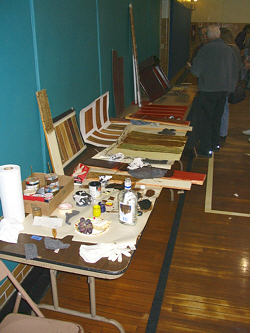 Chapter member George Bruno provided our technical presentation. George, who is perhaps best known for his work as a wooden movement clockmaker, ably demonstrated fine wood graining techniques for clock case restoration to an enthusiastic audience. For those who missed it, this talk was accompanied by some superlative examples! It is also worth noting that George's work--like George himself--gets better (if not mellower) all the time! Chapter member George Bruno provided our technical presentation. George, who is perhaps best known for his work as a wooden movement clockmaker, ably demonstrated fine wood graining techniques for clock case restoration to an enthusiastic audience. For those who missed it, this talk was accompanied by some superlative examples! It is also worth noting that George's work--like George himself--gets better (if not mellower) all the time!
Outgoing (but not-to-be-forgotten) president Jim Katzin addressed the membership, explaining the chapter's progress in transitioning to a management committee. Several members have volunteered to assume tasks formerly shouldered by Jim and his family. So far these include: Secretary/Treasurer: Cheryl Comen; Mailing & Printing: Don and Carol Montory; Speaker Coordination: Peter Beliveaux; Hospitality & Refreshments: Ethel Weber.
Our chapter's informality has proved to be its strength. However, as you know, there aren't any elections. Instead, we rely on volunteers to run meetings and events. Recent forward momentum on the road to new leadership is encouraging, but we still need a few volunteers. Someone is needed to pick up the food before meetings, and someone is needed to step forward to coordinate the whole merry crew as its president. So...if you enjoy our programs and marts and want them to continue, please consider what you can do to assist. Otherwise...the Lone Tableholder could be YOU!
- Mary Jane Dapkus with special thanks to Jim Barysh.
* * *
Meeting Highlights - Sept. 18, 2004
by Mary Jane Dapkus
The Chapter's September meeting began on an inauspicious note, as heavy rains that morning rendered driving difficult. In addition, we learned that chapter member and regular table holder Peter Brockett was too ill to attend, although friends reported he is welcoming calls and visitors.
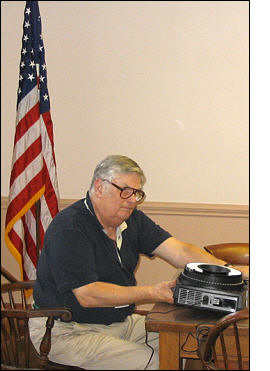 Arnoud Meurs provided the technical presentation, speaking from long years of experience and deep appreciation on the subject of mid-16th to late 19th century Japanese clocks. Arnold began by explaining that early Jesuit missionaries brought Western clockmaking skills to 16th century Japan. During this early period, clock ownership was limited to emperors and noblemen. Soon, however, shifting political winds drove Christians from the Empire. Arnoud Meurs provided the technical presentation, speaking from long years of experience and deep appreciation on the subject of mid-16th to late 19th century Japanese clocks. Arnold began by explaining that early Jesuit missionaries brought Western clockmaking skills to 16th century Japan. During this early period, clock ownership was limited to emperors and noblemen. Soon, however, shifting political winds drove Christians from the Empire.
Japan turned to its neighbor, China, for cultural influences including those related to timekeeping. Nonetheless, the Japanese retained much in the way of European technology.
The Oriental system of timekeeping was based on the length of time between sunup and sundown, and subsequently, between sundown and sunup. Thus early Japanese clocks had to account for seasonal progressions resulting in variable day lengths. Two ways of dealing with this problem evolved: constant-running movements with variable indications, and variable movements with constant or fixed indications.
Arnoud described several types of Japanese timekeeping devices which he also illustrated by means of a fabulous collection of slides: (1) the stick or pillar timepiece; (2) the striking clock; (3) bracket clocks; (4) lantern clocks (including floor, table and wall models); and (5) specialty clocks. Movements of conventional stick clocks were decorated with elaborate engraving. These clocks came in exquisitely decorated boxes that are themselves quite rare.
Stick clocks are sometimes found equipped with inset dials simply for the purpose of indicating whether the clock is running.
Striking pillar types have openings on the sides of the clock to disseminate the sound of the bell. Typical striking clock mechanisms were not weight driven, so clocks possessing both weights and side registers may have been altered. Variable running movements are most often encountered in lantern and bracket clocks. Within a variable speed movement, control passes back and forth between a pair of crown wheel and foliot mechanisms. Rare iron movements date from the mid-18th century or earlier.
Japanese musical clocks are also rare and much sought after. Exquisitely decorated hoods and cases of floor-model lantern clocks (intended to be viewed from a sitting position on the floor) are extremely delicate and fragile.
During the latter part of the 19th century, the Japanese emperor ordered that all clocks be capable of telling Western time. By this time, clock ownership was widespread among the populace. Following the imperial decree, many early clocks were modified.
In addition to antique Japanese clocks, Arnoud is both widely and well known for his expertise in Black Forest and Dutch horological antiquities. We are very grateful to Arnoud for de-mystifying this fascinating subject.
- Mary Jane Dapkus
* * *
Meeting Highlights - July 17, 2004
by Mary Jane Dapkus
Chapter 148 met on a sunny Saturday morning, July 17, 2004. Turnout was excellent. Our traditional meeting venue, the Edmond Town Hall gymnasium, was packed from wall to wall with heavily laden mart tables. Members delightedly examined offerings and scurried about cheerfully hoisting bulky treasures.
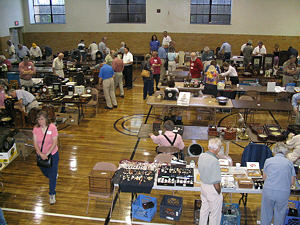 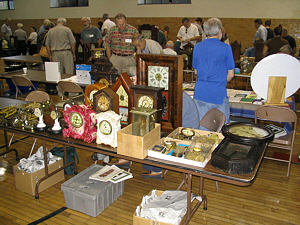
Scenes from the July '04 mart.
The author delivered a presentation on her ongoing research. Names of nearly one dozen individuals and firms have been encountered on wooden movement shelf clock labels with Middletown and Berlin, CT places of origin (ref. Eli Terry and the Connecticut Shelf Clock, Roberts and Taylor, 2nd ed., 1994, p. 348-352). However, little was known regarding these individuals and firms. The author related fragments of stories pieced together from archival sources, clock labels and movement data documenting connections between members of the Middletown and Berlin group. The reader is referred to the article appearing under "Research Activities and News" in the July, 2004 Bulletin for further information.
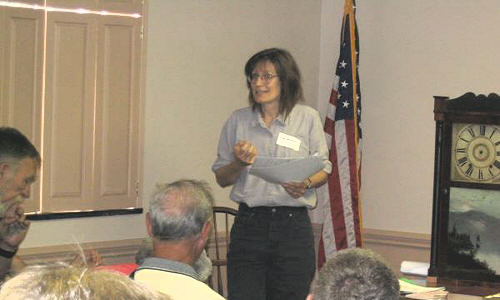
Mary Jane Dapkus presenting her Middletown and Berlin wood movement clockmakers project.
(So who is the mystery photographer of the chapter's chronicler/photographer?)
In addition to documentary information, the author is collecting movement, case style, label, saw mark and printer's line data for use in analyzing technical chronological developments and relationships between Middletown and Berlin, CT wooden movement clockmakers. She encourages members to contact her at Ch. 148 marts or by email at standapkus@earthlink.net if they have information relevant to this project.
Regrettably our Chapter learned that its president of many years, Jim Katzin, has decided to step down at the end of 2004 to give both his family and himself a break from the considerable duties of running this chapter. Indeed, the Chapter has benefited from Jim's remarkable leadership and organizational skills - qualities shared by his wife Phoebe and children Austin, Amy and Willie who are familiar to all of us in their respective roles managing our marts. As we are all aware, there can be few folks more thoughtful than the Katzins.
Jim has asked us to think about ways of assuming the duties now shouldered by himself and his family. (This is really too large a job for one person, even with a very supportive family.) Please consider what you might do to help and contact Jim asap to ensure a smooth transition to new leadership. And on behalf of Chapter 148: Thanks ever so much for a superb job, Jim!! Hope to see you and your family in 2005 - on the other side of our mart tables!
- Mary Jane Dapkus
Back to top of page
* * *American Clock & Watch Museum
Seminar Highlights - May 7, 2004
by Mary Jane Dapkus
Chapter members gathered at the American Clock and Watch Museum in Bristol, CT on a delightfully warm early spring Friday evening, May 7, 2004. We arrived to find doors flung open invitingly, chapter members engaged in lively discussion with the museum's hospitable staff and volunteers, and everyone trooping from room to room taking in the splendid horological, architectural and horticultural views - connected to the last detail with Connecticut's clockmaking history.
The group was treated to a presentation given by Tom Grimshaw entitled "The Development of the American Spring Clock". According to Tom, beginning in 1806, Eli Terry initiated a period of intense innovation. Imported coil springs were expensive. Such springs are found in clocks produced by Curtis & Clark. Although this firm ordered two hundred cases, no inscribed numbers greater than 100 have been found and a total of only about twenty examples are known.
Thoughtfully pausing to allow the crowd to appreciate eight o'clock in the museum's annex, Tom continued by explaining that E.C. Brewster supplied weight-driven wrought brass movement triple-decker clocks to the firm of Davis & Barber of Georgia. The movements in these clocks held precursors to the first Connecticut coil springs. Their pewter, ribbed winding drums may be attributable to Charles Kirk.
The first patent for a brass spring was granted to Joseph Shaylor Ives, nephew of Joseph Ives, on May 23, 1836. Both Ives and Charles Kirk worked in Brewster's factory. Some of Brewster's oversized beehive cases contained numbered brass 8-day, non-rolling pinion, blanked-plate rack and snail fusee movements with brass springs. These movements may have been produced as early as 1836. Nonetheless, the beehive cases may not have sold as well as the triple-decker style.
Following the Panic of 1837, standard fusee movements were not wildly successful, although E.C. Brewster's enterprise survived. After 1839, the firm became known as "E.C. Brewster & Co." Kirk's patented repeating cast iron back plate movement made a brief appearance.
Next, the firm of Brewster & Ingrahams appears to have made the inexpensive 8-day ribbed-plate, brass spring movement ca. 1843-1852. About 1847, S.B. Terry invented a process to produce steel springs but lacked capital to patent it. Brewster & Ingraham's inexpensive 30-hr. ribbed plate count-wheel movement followed.
By 1847-8, leaf springs were widely used. However, the coil spring invented by Terry, although imperfect compared to those produced by the French and English, was already out-competing the leaf spring. The steel coil spring was to dominate movement technology until well into the 20th century.
Chapter 148 extends sincere thanks to Tom and also to the museum's volunteers and staff for their warm welcome and a very enjoyable evening.
-- Mary Jane Dapkus
Back to top of page
* * *
Meeting Highlights - March 20, 2004
by Mary Jane Dapkus
Chapter 148's meeting held on Saturday, March 20, 2004, featured a technical presentation given by Ron Price focusing on the particular problems of digitally photographing horological objects in collections and preparing them for publication or web site displays. Ron began by introducing us to the basics of digital cameras and accessories. See pictures below. Handout notes of Ron's talk were provided. Copy is here:
http://www.plads.com/nawcc148/040320.doc
Because a point-and-shoot camera is generally unable to focus at distances less than two feet, a camera with macro capability is needed for photographing small objects such as watches. A memory card with adapter eliminates the need to use the camera's input/output cable and also enables plentiful photographs to be taken per session. Ron encourages using an AC power adapter to save money on camera batteries and time on charging them.
For horological publications and web designs, photographs need to be edited by means of software packages such as Adobe Photoshop (expensive), Picture Window ($50 to $90 versions), or others. For these applications cropping and resizing becomes absolutely necessary. However, Ron convinced us that software capable of sharpening, contrasting, color control and brightening can turn adequate horological photos into terrific ones -- with a little study and practice in using these features.
The present generation of digital cameras can store a staggering amount of detail. However, that much detail isn't distinguishable to the eye and is slow to download in the form of digital photos, especially for those of us with dial-up internet connections. The most thoughtful format in which to email digital photos after cropping is resized and sharpened to allow no more than 400 or 500 pixels per side.
To eliminate problem reflections, Ron uses a variety of light diffusers, including a styrofoam bag taped to the hood of the camera lens. Nevertheless, reflections sometimes enhance fine features such as damaskeening and engraving and in these cases the diffuser should be removed. Some objects such as leather watch bands absorb light and a diffuser isn't necessary.
For clocks, Ron advises carefully blocking reflections and unwanted lights with cloths, then photographing in a darkened room without using flash at a very slow shutter speed. The quality of the photo can then be improved by editing.
Contrary to conventional wisdom, natural light is often too strong and too blue for our purposes. Ron suggests using pure white 5000 color degree flood lights (not the natural blue type), or plain incandescent bulbs, which cause a weak beige tint that can be removed by desaturating with the editing program. Use of fluorescent lights produces very poor quality clock and watch photographs. Ron likes the True Color, full-spectrum OTT-LITE: his illustrations using various types of lighting were entertaining as well as enlightening.
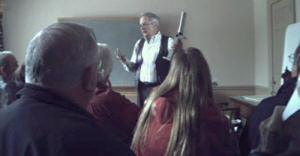 |
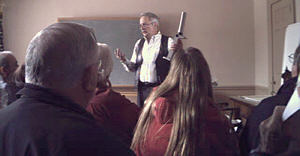 |
| In picture, Ron Price is explaining the advantages of the TrueColorTM (full-spectrum) OTT-LITE light. He is holding a portable unit, but various styles of lamps are available, including bulbs to replace incandescent bulbs in regular lamps. Note, in Mary Jane's original photograph on the left, the light blue color cast on Ron's white shirt and on his white background prop leaning against the right-side wall (actually a vinyl window shade, great for photographing clocks). The blue cast was caused by sunlight coming through the windows; lights were turned off in the room. The color cast might be cool for human eyes, but this is what stainless steel and coin silver watches will look like when photographed in the shadow of natural light. The blue color cast was removed in the edited picture on the right. The right picture was also sharpened with the image editor whereas the original picture was not sharpened for this illustration. Sharpening was needed because Mary Jane's original photograph was resized smaller for this web page after cropping out the unwanted view of the ceiling (300 pixels wide). |
Presently Ron operates and manages "Price-Less Ads", a professional web design firm specializing in horological applications. He is the author of a soon-to-be-published monograph on the origins of the Waltham Model 57 watch, an avid collector and researcher. In addition, Ron is Chapter 148's esteemed webmaster. He hails from Natick, MA.
We are very grateful to Ron for a most enjoyable, informative presentation.
* * *
Meeting Highlights - January 17, 2004
by Mary Jane Dapkus
Our pleasant, post-holiday gathering took place on January 17, 2004. The Chapter's plucky members endured single-digit outdoor temperatures to meet warmly at the Edmund Town Hall over mart and refreshments.
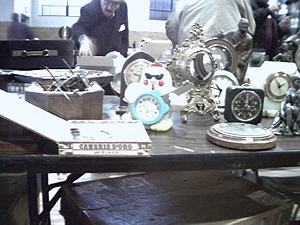 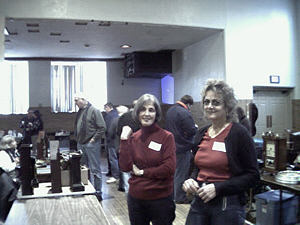
Scenes from the January '04 mart.
Chapter 148's first meeting ever took placed in July of 1990. Founded by our past president, the energetic and resourceful John Salva, it may be said that we are enlivened (rather than bound) by several traditions. For a brief history of the Chapter, the reader is referred to meeting highlights written by Dominic Viglione found on pages 426 and 427, Bulletin No. 296 (June, 1995).
-- Mary Jane Dapkus
* * *
|





 Chapter 148 met on Saturday, November 20, 2004. Perhaps the most revealing testament to our Chapter's vitality is the fact that more folks sought table space in the ample Edmond Town Hall gymnasium than there were tables. The solution? Bring your own table! (See photo.)
Chapter 148 met on Saturday, November 20, 2004. Perhaps the most revealing testament to our Chapter's vitality is the fact that more folks sought table space in the ample Edmond Town Hall gymnasium than there were tables. The solution? Bring your own table! (See photo.) Chapter member George Bruno provided our technical presentation. George, who is perhaps best known for his work as a wooden movement clockmaker, ably demonstrated fine wood graining techniques for clock case restoration to an enthusiastic audience. For those who missed it, this talk was accompanied by some superlative examples! It is also worth noting that George's work--like George himself--gets better (if not mellower) all the time!
Chapter member George Bruno provided our technical presentation. George, who is perhaps best known for his work as a wooden movement clockmaker, ably demonstrated fine wood graining techniques for clock case restoration to an enthusiastic audience. For those who missed it, this talk was accompanied by some superlative examples! It is also worth noting that George's work--like George himself--gets better (if not mellower) all the time! Arnoud Meurs provided the technical presentation, speaking from long years of experience and deep appreciation on the subject of mid-16th to late 19th century Japanese clocks. Arnold began by explaining that early Jesuit missionaries brought Western clockmaking skills to 16th century Japan. During this early period, clock ownership was limited to emperors and noblemen. Soon, however, shifting political winds drove Christians from the Empire.
Arnoud Meurs provided the technical presentation, speaking from long years of experience and deep appreciation on the subject of mid-16th to late 19th century Japanese clocks. Arnold began by explaining that early Jesuit missionaries brought Western clockmaking skills to 16th century Japan. During this early period, clock ownership was limited to emperors and noblemen. Soon, however, shifting political winds drove Christians from the Empire.

